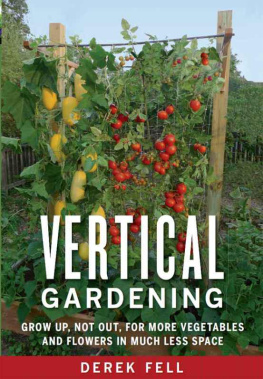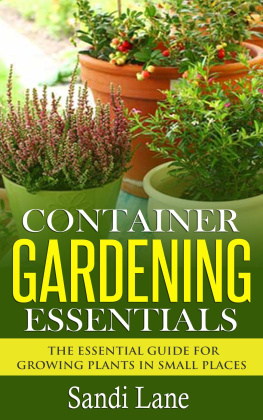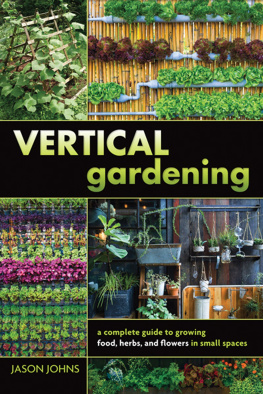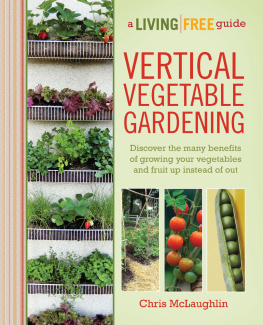

Contents
VERTICAL GARDENING:
THE SENSIBLE WAY TO GARDEN EFFORTLESSLY
Vertical Gardening: The Sensible Way to Garden Effortlessly
Vertical gardening is the way to grow! You can make the most of your garden space by growing delicious vegetables and fruits and colorful flowers up on a trellis, on garden netting, in a tower of pots, and over garden structures, while enjoying the benefits of easier maintenance, healthier plants, effortless harvesting, and higher yields.
GROWING UP FROM HERE
Once you learn how easy it is to change your garden from a horizontal system to a vertical one, you'll be rewarded with a garden that involves less work and more benefits. Even people with plenty of space for a garden are finding that traditional ways of gardening (with long horizontal rows) can lead to disappointing resultsthe more space you try to cultivate, the more likely you are to get discouraged by aggressive weed growth, encounter problems such as pests and diseases, find that watering a large area is a never-ending commitment, and get overwhelmed when there's so much garden to care for on a weekly basis.

Create a visual vertical garden by simply placing containers at different heights. Here abundantly flowering coleus and geraniums fill containers on the steps and railings of a patio.
After years of research in my own gardens, I've developed and honed the art of vertical gardening, and I'm anxious to spread the word. Vertical gardening will change your old way of growing plants in rows and beds. If you're one of the millions of people who want to experience gardening for the first time, one of the millions of gardeners looking for easier and more rewarding ways to garden, or one of the millions of gardeners who have given up on gardening because of disappointing results, consider the incredible benefits of my vertical gardening experience:

Cedaridge Farm's large vegetable garden features raised beds with bamboo trellises, offering the opportunity to grow and test hundreds of varieties of climbing, foundation, support, and container plants. In the background, topknots of Japanese dappled willow outline the neighboring herb garden.
- Growing plants up, not out, in beds with a small footprint
- Less soil preparation and digging from Day 1
- More plant variety in much less space
- Many opportunities to create bottom-up and top-down plantings
- Less weeding in vertical beds, spaces, and pots
- Many space-saving container and stacking options
- Fewer maintenance chores
- Improved air circulation and less risk of plant diseases and pests
- Easier tending and harvestingall at eye level
- Less bending and less backbreaking work
- Larger yields in a compact space
- Top-performing vertical vegetables, fruits, and flowersespecially vining types
- And much, much more fun!
The biggest mistake gardeners make in planting a garden is starting too big. After they dig the soil in a large garden plot and plant a traditional horizontal garden in long, straight rows or large raised beds, summer days get hot and humid, encouraging a forest of weeds and creating a daily need for plant watering. Gardeners get busy with summer activities, and it's a challenge to find enough time to tend flowers or vegetables. When the harvesting, cooking, and preserving becomes time-consuming and overwhelming, gardeners give up and just let their gardens sprawl out of controluntil a cold snap hits and the disappointing results are put to bed for another year. But it doesn't have to be this way!

Author Derek Fell displays a day's harvest from his tomato plants, including large Beefsteak varieties and small, multicolored cherry tomatoes.
My father grew delicious beansnot the dwarf kinds, but pole varieties in manure that produce tall vines and dense foliage to give them the best flavor.
Jean Renoir, Renoir, My Father
Vertical gardening saves time and work, allowing you to spend less time tending and more time enjoying your garden. As you delve into each chapter of this book, you'll find my best advice and tips for creating planting beds of small spaces or strips of soil; using trellises and supports in new and attractive ways; and choosing the best plants for climbing, cascading, and growing vertically.
MY LIFE IN THE GARDEN
Some people find their passion late in life; I found mine in childhood. I planted my first vegetable garden at the age of 6, after my grandfather gave me a packet of garden peas. It was during World War II, and food was scarce. I lived with my parents in a row house in the north of England, with a small walled-in concrete yard that backed onto a narrow lane. The only patch of bare soil was a narrow sunny strip between our back wall and the lane. As my grandfather instructed, I dug up the soil and mixed in all kinds of organic ingredients he said would feed the plantswood ashes from our fireplace, tea leaves and coffee grounds, crushed eggshells, and horse manure collected in a bucket after our milkman delivered milk each morning from a horse-drawn cart. I made a trellis from scraps of lumber, forming a frame for a network of crisscrossed string to support the pea vines.
I checked the site daily for signs of germination, and after 7 days of suspense, I saw small green shoots poke through the soil. I watered them, helped the tendrils grip the makeshift netting, picked off slugs whenever I saw signs of their chewing, and watched the vines grow up toward the sun. It was thrilling to see the plants set dozens of white flowers and then develop shiny green pea pods. As soon as the pods fattened up, I picked them, shelled some of the peas, and ate them fresh off the vine. They were sweet and deliciousa memory I will treasure forever. The rest of the harvest I proudly showed to my grandfather, who cooked up a special meal of dumplings, pork, and sauerkraut with cooked peas as a side dish. I have been growing gardens vertically ever since and never miss a year with peas!
A healthy soil means healthy plants and healthy people.
Dr. W. E. Shewell-Cooper, Soil, Humus and Health
At age 17, I wrote my first garden article for the Shrewsbury Chronicle newspaper group about the Shrewsbury Flower Show, interviewing contestants who had grown giant dahlias and leeks as thick as a man's arm. At 19, I began working for Europe's oldest established seed house, Hurst Seeds, as their catalog manager. After winning an award for their wholesale catalog, I was invited to move to the United States to work as a catalog manager for Burpee Seeds, the world's largest mail-order seed house, at their Fordhook Farm research facility in Doylestown, Pennsylvania. I quickly realized the value of having a test garden to evaluate plant varieties and different growing techniques. After 6 years with Burpee, I was appointed executive director of both the National Garden Bureau, an information office sponsored by the American seed industry, and All-America Selections, the national seed trials. Immediately I set a goal to own a farm for the purpose of conducting my own trials. In 1974, as head of the National Garden Bureau, I was appointed by the Ford Administration to be chairman of a committee to plant a vegetable garden at the White House; one of my vegetable garden designs had appeared in the Sunday edition of the
Next page











